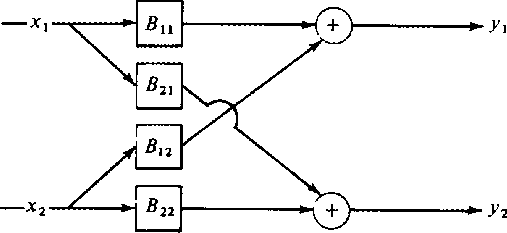|
5-2
Figure 1 Two time series x1 and x2 input to a matrix of four filters illustrates the general linear model of multichannel filtering. |  |
|
5-2
Figure 1 Two time series x1 and x2 input to a matrix of four filters illustrates the general linear model of multichannel filtering. |  |
The filtering operation in the figure can be expressed as a matrix times vector operation, where the elements of the matrix and vectors are Z transform polynomials. That is,
| |
(39) |
![]()
Now we can address ourselves to the inverse problem;
given a filter B and the outputs Y how
can we find the inputs X?
The solution is analogous to that of single time series.
Let us regard ![]() as a matrix of polynomials.
One knowns, for example, that the inverse of
any
as a matrix of polynomials.
One knowns, for example, that the inverse of
any ![]() matrix
matrix
![\begin{displaymath}
\left[ \begin{array}
{cc}
a & b \\ c & d \end{array} \right...
...ay}
{cc}
d & -b \\ -c & a \end{array} \right] \over {ad - bc}}\end{displaymath}](img119.gif)
![]()
When one generalizes to many time series, the numerator matrix is the so-called adjoint matrix and the denominator is the determinant. The adjoint matrix can be formed without the use of any division operations. In other words, elements in the adjoint matrix are in the form of sums of products. For this reason, we may say that the criterion for a minimum-phase matrix wavelet is that the determinant of its Z transform has no zeros inside the unit circle.
Equation (39) is a useful description of Figure 1 in most applications. However in some applications (where the filter is an unknown to be determined), a transposed form of (39) is more useful. If b12 was interchanged with b21 in Figure 1, we could use the ``row data'' expression
| |
(40) |
Now that we have generalized the concept of filtering from scalar-valued time series to vector-valued series, it is natural to generalize the idea of spectrum. For vector-valued time functions, the spectrum is a matrix called the spectral matrix and it is given by
![\begin{eqnarray}
{\bf R}(\omega) &= & \left[
\begin{array}
{cc}
r_{11} & r_{12} ...
...erline{Y}_2 Y_1 & \overline{Y}_2 Y_2 \end{array} \right] \nonumber\end{eqnarray}](img124.gif) |
(41) | |
![]()
![]()
| |
(42) |
![\begin{eqnarray}
{\bf R} &= & \left[
\begin{array}
{cc}
\overline{B}_{11} & \ov...
...cc}
{B}_{11} & {B}_{12} \\ {B}_{21} & {B}_{22} \end{array} \right]\end{eqnarray}](img131.gif) |
||
| (43) |
Single-channel spectral factorization gives insight into numerous important problems in mathematical physics. We have seen that the concepts of filter and spectrum extend in quite a useful fashion to multichannel data. It was only natural that a great deal of effort should have gone to spectral factorization of multichannel data. This effort has been successful. However, in retrospect, from the point of view of computer modeling and interpretation of observed waves, it must be admitted that multichannel spectral factorization has not been especially useful. Nevertheless a brief summary of results will be given.
The root method. I extended the single-channel root
method to the multichannel case.![[*]](http://sepwww.stanford.edu/latex2html/foot_motif.gif) The method is even more cumbersome in the multichannel case.
A most surprising thing about the
solution is that it includes a much broader result: that a polynomial with
matrix coefficients may be factored.
For example,
The method is even more cumbersome in the multichannel case.
A most surprising thing about the
solution is that it includes a much broader result: that a polynomial with
matrix coefficients may be factored.
For example,
![]()
![\begin{eqnarraystar}
&& \left\{ I + Z \left[
\begin{array}
{rr}
2 & -1 \\ 20 & ...
...in{array}
{rr}
1 & -1 \\ 12 & -6 \end{array} \right] \right\} \end{eqnarraystar}](img134.gif) |
||
The Toeplitz method. The only really practical method for finding an invertible matrix wavelet with a given spectrum is the multichannel Toeplitz method. The necessary algebra is developed in a later section on multichannel time series prediction.
The exp-log and Hilbert transform methods. A number of famous mathematicians including Norbert Wiener have worked on the problem from the point of view of extending the exp-log or the Hilbert transform method. The principal stumbling block is that exp(A + B) does not equal exp(A) exp(B) unless A and B happen to commute, that is, AB = BA. This is usually not the case. Although many difficult papers have appeared on the subject (some stating that they solved the problem), the author is unaware of anyone who ever wrote a computer program which works at fast Fourier transform speeds as does the single-channel Hilbert transform method.
![]()
![]()